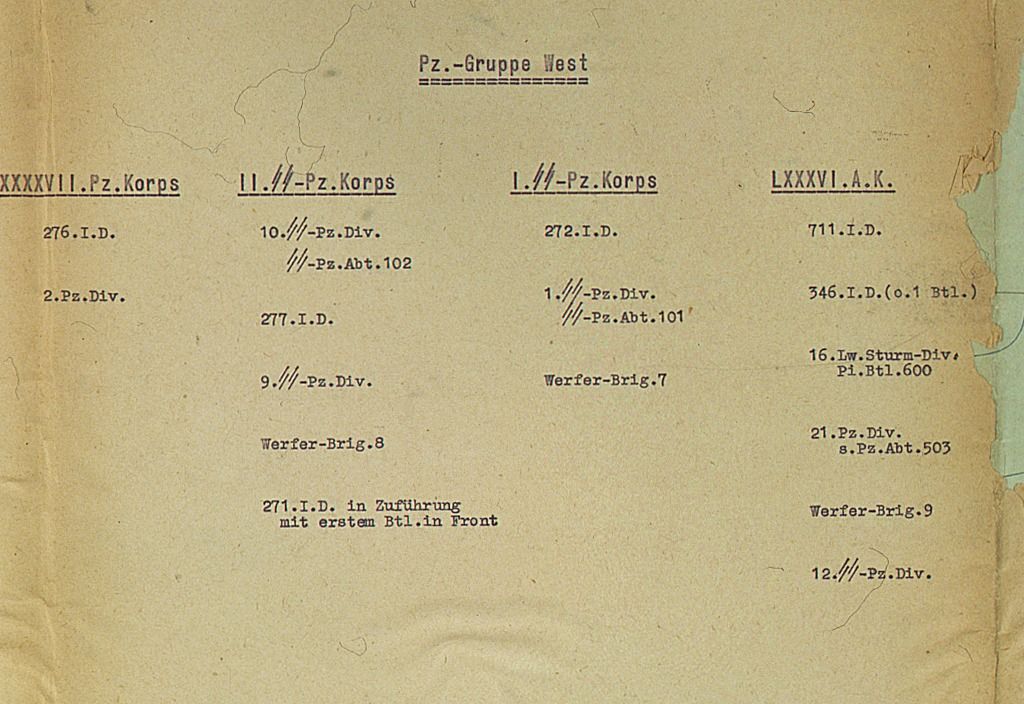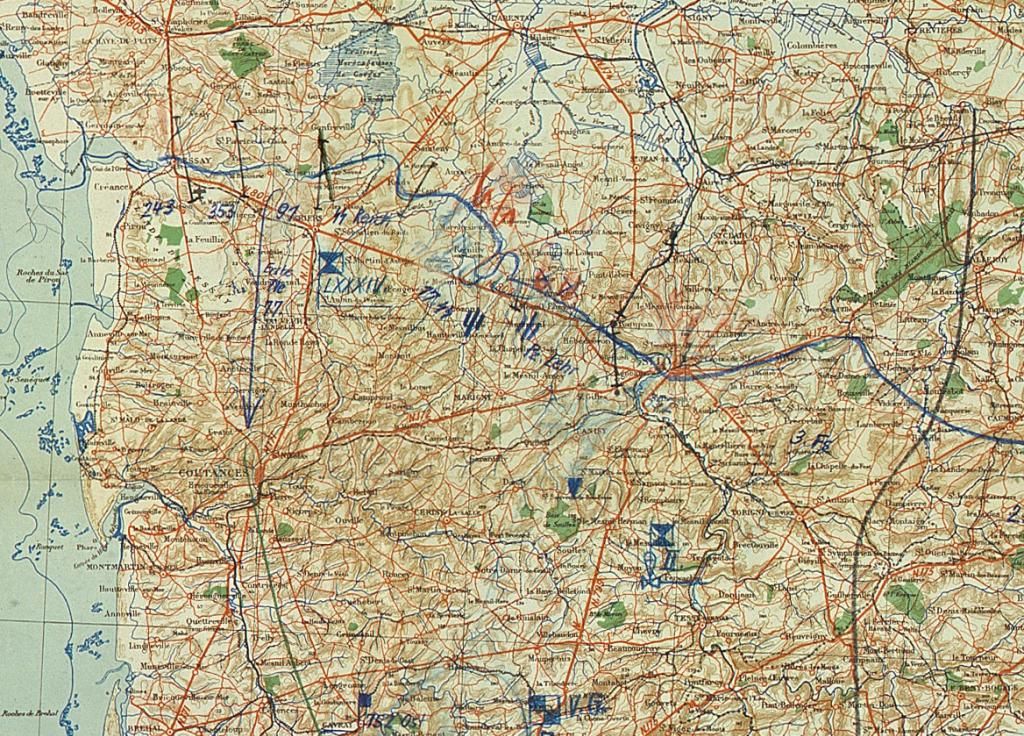
http://www.etherit.co.uk/month/thismonth/18.htm
July 18th, 1944 (TUESDAY)
UNITED KINGDOM: London is fast emptying under the flying-bomb attack. More than 500,000 mothers and children have been evacuated, and more are leaving daily. Another half a million people, including the elderly and the homeless, are leaving as “aided” evacuees, with rail warrants and billeting allowances. The evacuation is outstripping that of 1939-40. The eight deep shelters specially built after the Blitz, 100 feet underground, are being used for the first time. Each of them has bunks for 8,000 people. “Bomb Alley”, the path that the flying bombs take across Kent and Sussex and the south-east suburbs of London such as Croydon, Lewisham, Bromley, Bexley and Orpington, is suffering particularly heavily. Some 200,000 houses have been destroyed or damaged.
Defences against the V1s have improved. Fast-flying fighters are patrolling the Channel 20 miles out to sea, shooting down V1s or tipping them over with their wingtips. Over 1,500 guns are massed along the coast, and on the Downs 1,750 balloons form a barrage. More than half of the incoming V1s are being destroyed.
Minesweeper HMS Styx laid down.
Destroyer HMS Zambesi commissioned.
The USAAF’s Eighth Air Force in England flies Mission 481: 1,394 bombers and 476 fighters are dispatched to hit targets in Germany and tactical targets in France; three bombers and three fighters are lost:
1. 644 B-24s are dispatched, in conjunction with Ninth Air Force and RAF Bomber Command, to bomb enemy equipment and troop concentrations in support of the assault by the British Second Army in the Caen area; 249 hit Solier, 146 hit Frenouville, 139 hit Troarns, 23 hit Hubert la Folie and 12 hit the Mezidon marshalling yard; a B-24 is lost; 90 RAF Spitfires fly uneventful support for the B-24s.
2. Of 291 B-17s dispatched, 107 hit the Kiel port area, 55 hit the Hemminstedt oil refinery and 54 hit Cuxhaven. Escort is provided by 48 P-38 Lightnings and 84 P-51 Mustangs without loss.
3. Of 459 B-17s dispatched, 377 hit the Peenemunde experimental establishment, scientific HQ at Zinnowitz, and marshalling yards at Stralsund; three B-17s are lost. Escort is provided by 297 P-38s and P-51s; they claim 21-0-12 Luftwaffe aircraft; three P-51s are lost .
25 B-24s fly CARPETBAGGER missions in France during the night; a B-24 collides with an RAF aircraft over France and is lost.
ENGLISH CHANNEL: U-672 sunk north of Guernsey, in position 50.03N, 02.30W, by depth charges from frigate HMS Balfour. 52 survivors (No casualties).
NORTH SEA: U-286 Type VIIC Sank the first time 17th March, 1944 in the Baltic Sea east of R¸gen after collision with U-1013. 26 survivors. Raised and repaired and returned to duty.
Today a Norwegian Mosquito aircraft (Sqdn 333/K) attacked the boat, causing damages and killing 1 man and wounding 7 more. The boat reached Kristiansand, Norway on the same day.
Finally sunk 29th April, 1945 in the Barents Sea north of Murmansk, Russia, position 69.29N, 33.37E, by depth charges from the British frigates HMS Loch Insh, Anguilla and Cotton. 51 dead (all hands lost). (Alex Gordon)
U-742 sunk west of Narvik in position 68.24N, 09.51E, by depth charges from an RAF 210 Sqn Catalina. 52 dead (all hands lost)
HMS Formidable 8 BTR Wing/Leader Barracuda a/c #LS556, LCdr(A) Roy S. Baker-Faulkner DSO, DSC, RNR, (Canadian) lost after ditching off Norway.
FRANCE: US XIX Corps has almost completed the capture of St. Lo, France. In one of the most bruising and brilliant actions of the Normandy campaign, the Americans captured the heights of St. Lo and are poised to break out of the difficult bocage country of hedgerows and narrow roads. The cost was heavy - 5,000 casualties - but the German 352nd Division has been smashed and General Meindel’s crack Parachute Corps broken.
The Americans have been battling for the St. Lo to Coutances road since the beginning of the month. After 12 days they had advanced seven miles at a cost of 10,000 casualties. The bocage hedgerows shielding sunken lanes and bounding small fields has proved ideally suited to a defensive battle, providing ample cover for the Germans and making advance difficult.
The British and Canadians begin a major attack east of Orne River to the south. They are heading for the high ground beyond Caen. This is Operation Goodwood. Montgomery hopes is will lead to a break out from Normandy. It features heavy bomber support from more than 2200 aircraft.
At 0530 hours in Operation GOODWOOD RAF Bomber Command drops 6,000 one-thousand pound bombs and 9,600 500 pound bombs on Panzer Group West east of the River Orne. At 0700 medium bombers of the USAAF 8th and 9th Air Forces began another bombing attack but had to return to their bases without dropping bombs due to clouds of smoke and dust which prevented the navigators from locating their targets. At 0830 more bombers of the USAAF dropped nearly 13,000 hundred pound and over 76,000 twenty pound bombs in support of the British Second Army. (W Jay Stone)
In France, 400+ USAAF Ninth Air Force B-26 Marauders and A-20 Havocs hit various military targets in support of the ground forces in the Caen area, and later in the day bomb rail and highway bridges beyond the frontlines; large number of fighters fly escort, dive-bomb gun positions at Rouen and Mantes-la-Jolie, hit military targets in the Chartres area (using rockets), attack gun positions, bridges, and other targets in the Benney-Alencon- Saint-Lo area, and fly armed reconnaissance and fighter sweeps over wide areas of northern and western France.
GERMANY:
U-2504, U-3003 launched
U-327, U-2323 commissioned.
ITALY: Elements of the US IV Corps begin an attack on Leghorn on the west coast of Italy. The Polish 2 Corps capture Ancona.
WESTERN EUROPE: Targets in France and Germany are attacked by the Eighth and Ninth Air Forces in England and the Fifteenth Air Force in Italy.
-The Eighth Air Force dispatches 1,394 bombers and 476 fighters on Mission 481 to hit targets in Germany and tactical targets in France; 3 bombers and 3 fighters are lost:
- 644 B-24s, in conjunction with Ninth Air Force and RAF Bomber Command, bomb enemy equipment and troop concentrations in support of the assault by the British Second Army in the Caen area; 1 B-24 is lost; 90 RAF Spitfires fly uneventful support for the B-24s.
- 291 B-17s are dispatched to bomb the Kiel port area, the Hemminstedt oil refinery and Cuxhaven; escort is provided by 48 P-38s and 84 P-51Mustangs without loss.
- 377 B-17s hit the Peenemunde experimental establishment, scientific HQ at Zinnowitz, and marshalling yards at Stralsund; 3 B-17s; escort is provided by 297 P-38s and P-51s.
- 25 B-24s fly CARPETBAGGER missions in France during the night; 1 B-24 collides with an RAF aircraft over France and is lost.
-The Ninth Air Force dispatches 400+ B-26 Marauders and A-20 Havocs to hit various military targets in support of the ground forces in the Caen area, and later in the day bomb rail and highway bridges beyond the frontlines; large number of fighters fly escort, dive-bomb gun positions at Rouen and Mantes-la-Jolie, hit military targets in the Chartres area (using rockets), attack gun positions, bridges, and other targets in the Benney-Alencon-Saint-Lo area, and fly armed reconnaissance and fighter sweeps over wide areas of northern and western France.
- In Germany, 200 Fifteenth Air Force B-24s and B-17s attack Memmingen Airfield and the Dornier aircraft works at Manzell, and Casarsa della Delizia railroad bridge in Italy; 250-300 Luftwaffe fighters oppose the formations attacking targets in Germany, beginning the interception at the North Adriatic coast, continuing to the targets and back as far as the Brenner Pass; 20 USAAF aircraft are lost.
Lt. C.D. “Lucky” Lester was flying a P-51 Mustang with the 332nd Fighter Group, an all-African American unit. The group was flying a bomber escort mission at 25,000 feet over northern Italy when they engaged a formation of German Messerschmitt Bf 109s. Lucky saw a 109 straight ahead and closed to about 200 feet while firing. The 109 exploded and, as Lucky was dodging pieces of aircraft, he saw another to his right.
He turned onto its tail and again closed to 200 feet and fired. This aircraft started to smoke and dived toward the ground. Lucky followed it to about 8,000 feet until he saw the enemy pilot bail out. Lucky, down to 1,000 feet, then spotted a third 109 coming down after him. When the enemy plane overran his P-51, Lucky pulled behind it and opened fire. The Messerschmitt rolled upside down and dived straight into the ground. Lucky earned the Distinguished Flying Cross for his actions in the engagement, which took only six minutes. (Ron Babuka)(http://www.swagga.com/aviation.htm)
Picture of the action. Picture of the man.
GREECE: Aegean Sea: German troops round up the 2,000 Jews of Rhodes and Kos for deportation, via Athens and Hungary, to Auschwitz-Birkenau.
U.S.S.R.: The First Belorussian Front near Kovel begins an offensive; the Thrid Baltic Front advances toward Ostrov ans Pskov, while the First Ukraine Front is beginning to make progress towards Lvov after two days on the offensive.
At 0321, U-479 fired a spread of two torpedoes at Soviet ASW patrol craft MO-304 in Viborg Bay and thought that she missed, but the submarine chaser lost her fore section. The after part was towed into port and repaired.
MARIANAS ISLANDS: Continuing the preinvasion missions in the Mariana Islands, Seventh Air Force P-47s based on Saipan pound Tinian and Pagan Islands; Far East Air Forces (FEAF) B-24s strike Yap Island, bombing the town and Blelatsch peninsula; several of the B-24s bomb Sorol Atoll; and 25 Seventh Air Force B-24s, staging through Eniwetok Atoll, attack Truk Atoll.
JAPAN: General Hideki Tojo resigns as Prime Minister and Army Chief of Staff in the Japanese Cabinet. He takes his cabinet with him after a behind-the-scenes coup by a cabal of ex-premiers convinced that Japan faces defeat unless drastic changes are made. The former leaders, who backed Tojo’s appointment 33 months ago, have advised the emperor to summon General Kuniaki Koiso and Admiral Mitsumasa Yonai to form a new cabinet, with separate posts for the heads of the army and navy. Tojo tried to save his premiership by agreeing to step down as army chief, but this did not placate the ex-premiers. Events in the Marianas have brought down his cabinet. General Umezu will become the New Army Chief of Staff. This is the first change in cabinet by the Japanese since 1941.
U.S.A.: Destroyer escort USS Ulvert M Moore commissioned.


I cropped the Orders of Battle for today. They show that despite the hammering and heavy combat by British 2nd Army against Panzer Group West, the German unit is maintaining it’s cohesion. In fact, in the past 10 days there have been a few units added, and only Panzer Lehr has been removed, sent to 7th Army. Admittedly, the German divisions are slowly being ground down by Monty’s attacks, and they are not receiving replacements or new equipment. But they are maintaining a continuous front and are keeping their units whole and intact.


In the 7th Army sector, on the other hand, it’s chaos. Particularly in LXXXIV Corps. Despite the fact that the American July Offensive has pretty much petered out, LXXXIV Corps is just a mish-mash of Kampfgruppen formed around “divisions” that are just blue marks on the map. And even then, a regiment of one division can be holding a sector 15 miles away with the jumble of two or three other divisions between them. They managed to keep the Americans from breaking through, but it’s hard to see how this patchwork of burned-out shells of divisions could survive another blow.
I’d love to be close enough to see the shoulder patches on the soldiers on that ship. I wonder if they are part of Third Army on their way to France?